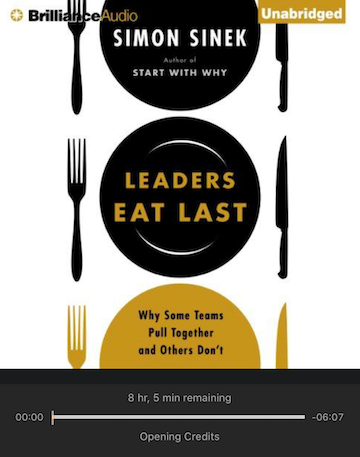Leaders Eat Last by Simon Sinek

Sticking to the recent focus on leadership, this was another book that centered around improving leadership and becoming a better and more effective leader. One of the other books from the Audible sale a few weeks back, this book was pretty good. Simon Sinek is someone who I respect and who I see expresses great morals throughout all he does.
This is laughable to me. Follow through is most important and so many people who advertise or promise certain things don’t follow through or provide results. In terms of politicians, I guess it’s just understood or accepted that they’ll only do what they’re campaigning to do if they’re elected. Is it any wonder that Congress has a lower approval rating than used car salesman? (Per data Simon included in the book, linked here).
Simon notes that it’s fun to watch politicians who say if they will be elected they will do all these things because they care about us. Yet, if they lose the election, many go on to do none of those things. The rank of office is not what makes someone a leader.
Leadership is the choice to serve others with or without any formal title.
This makes me think of the African proverb, “if you want to go fast, go alone. If you want to go far, go together.” With that in mind, it’s imperative that we have a great team if we want to build something long lasting. Personally, I’ve never been too keen on blindly following the rules. I greatly prefer to always strive to do what’s best for everyone involved and if I have to break or change a few rules, I won’t lose any sleep over that.
For trust to serve the individuals and the group it must be shared. The responsibility of leaders is to teach their people the rules, train them to gain competency, and build their confidence.Leadership must then step back and trust that their people know what they’re doing and will do what needs to get done.
In weak organizations, people will break the rules for personal gain.
In strong organizations, people will break the rules because it’s the right thing to do for others.
We don’t trust rules, we trust people.
What stood out to me when I was moving through this section of the book were the simple examples of real life scenarios that displayed the validity. The author elaborated upon the importance of face-to-face engagement by referencing a blogger’s conference that takes place in Las Vegas. He stressed that while the bloggers primarily reside online they found it essential to interact in person. I believe that the importance of personal communication cannot be overstated.
Managing and getting past the abstract world:
1. Keep it real, virtual communication only goes so far.
2. Keep it manageable, 150 is about the number of relationships that we are naturally designed to manage. It’s much easier to be willing to help and care for the people that we actually know. This is one reason why hierarchies are essential.
3. Meet the people you help, our bosses telling us how important our work is is nowhere near as impactful as seeing it for ourselves. This was displayed by the Wharton School of Business fundraising department. The loan department at Wells Fargo Bank expressed the same thing, so did a study that showed diagnostic findings were more accurate if radiologists had been shown simply a photograph of patients. We are naturally more inspired by helping others than helping ourselves.
4. Give them time, not just money, time is valued more highly as it’s not replaceable while we can always get more money. Without attention, time giving is wasted. Loyalty is produced by time; leaders must show they’re willing to sacrifice their time and energy.
5. Be patient, the rule of 7 days and 7 years, it takes more than 7 days and less than 7 years to build trust.
The following quote was one of my favorite takeaways from the whole book. A leader who does not allow their followers to have authority over their domains is no leader at all.
“The goal of a leader is to provide no orders. Leaders are to provide direction and intent and allow others to figure out what to do and how to get there.” — David Marquet
This is something that I’ve actually debated about recently with a few of my peers. As I look toward the future, I know that this will be something I will spend a great deal of time and energy investigating at a deeper level. Understanding the resulting human behaviors will be imperative for my organization’s continued success.
For the most part, incentive structures offered within companies do not promote cooperating, sharing information, or reaching across the company to offer or ask for help. This means that there is little positive reinforcement when it comes to behaviors and actions critical to maintaining the circle of safety. The circle of safety is something Simon used to refer to what happens when everyone inside the circle looks out for each other.

It’s always great to learn more about leadership and this book was certainly a great one about it. The numerous studies and examples of people doing many of these things well is what most inspired me. Thoughts or hypotheses without testing and proof as a result is nothing to me. Simon is always someone I have great respect for. He is a magnificent orator and someone who certainly provides some wonderful messages and insights for his readers.
I gave this book a 3.5/5